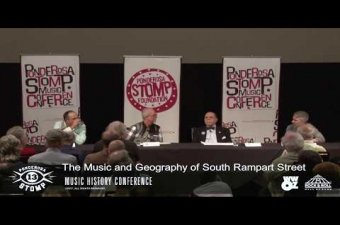Astoria Hotel
235 South RampartNew Orleans LA 70112
As a young man in the late 1800s, Henry E. Braden, Sr. moved to New Orleans from the cotton fields outside Natchitoches, Louisiana. He opened a restaurant here called the Astoria, which he eventually expanded to include a barbershop, pool room, tavern, hotel, and the Astoria Gardens dance hall, one of the largest in the South for Black audiences. (Successive generations of Bradens would go on to serve prominently in the civic life of New Orleans, often as the first people of color in their respective positions.)
For decades the Astoria was a fixture of African-American society, hosting artists like Duke Ellington and Count Basie and luminaries of the Black intelligentsia. For visitors turned away elsewhere in the Jim Crow South, the dignified service at the hotel was an oasis.
It was popular for locals, too, who came here to eat, drink, and dance. Some also came to gamble — Edwin “Beansie” Fauria, a part owner of the Astoria, was known to have a hand in such things in addition to his work managing nightclubs.
In 1929, house bandleaders Lee Collins and David Jones called themselves the Jones & Collins Astoria Hot Eight when they cut a record at the Unione Italiana – reportedly the first racially mixed recording session in New Orleans. Other local favorites appearing here were Papa Celestin’s band and the Tuxedo Jazz Band. Blues singer Blanche Thomas made her professional debut at the Tick Tock Tavern on the building’s second floor.
Clyde Kerr, Sr. grew up listening to Louis Armstrong records on the jukebox in the Astoria restaurant on his way to McDonogh No. 35 High School up the street. He went on to form the Clyde Kerr Orchestra, which held a regular Sunday night gig at the Tick Tock with future R&B pioneer Dave Bartholomew on trumpet.
In 1938, the (white) magazine Spot described the Astoria dance hall painted bright orange and blue, with performances in which “the band is scheduled to work nominally until 2 a.m., but they seldom leave before down, unless the musicians are in a downcast mood, which is rare.” As for the music, “The older dancers prefer to move a little more slowly, and prefer blues accompaniment. The large percentage, though, like the music hot and fast, and they get it that way mostly all night long.”
The Astoria building survived longer than many on South Rampart, but was torn down in 1975.
About South Rampart Street
South Rampart Street was the main commercial corridor in “back o’ town,” originally a swampy area at the back end of the city where New Orleans’ racial order relegated black residents in the late 1800s. The strip filled with businesses—many run by Jewish, Italian, and Chinese merchants—catering to a black clientele. Among these were dance halls, juke joints, tailors who outfitted bands with uniforms, and pawn shops that bought and sold instruments.
Churches here tended to be Protestant, with emotive spirituals and hymns in their services that reverberated through the neighborhood. To the ministers’ chagrin this area included Black Storyville, the red light district for those barred from the whites-only bordellos and gambling houses just across Canal Street. This traffic fueled some social ills. It also helped attract audiences for working musicians. (Business continued after 1917, when the white vice district—Storyville—shut down).
In 1938, the WPA City Guide called South Rampart “The Harlem of New Orleans.” It was full of music, from barrelhouse piano players like Tuts Washington to big bands like Papa Celestin’s. The street itself was a venue, with benevolent societies and social clubs parading with brass bands, and, on Carnival, the Zulu parade, Baby Dolls, and chanting bands of Mardi Gras Indians.
The strip was referenced in popular songs, from the traditional jazz tune “South Rampart Street Parade” to Louis Jordan’s jump blues hit “Saturday Night Fish Fry” in 1949, about a house on Rampart “rockin’” till the break of dawn.
While the “New Orleans sound” of R&B played across the country in the 1950s, South Rampart Street went the way of other black inner city neighborhoods in the age of urban renewal. Whole blocks were demolished and redeveloped, paving the way for a new city hall and today’s Central Business District.
Videos

From the 2017 Ponderosa Stomp Music History Conference, Richard Campanella, Bruce Raeburn, and "Deacon" John Moore discuss music on South Rampart Street with Jordan Hirsch.
Video from Ponderosa Stomp.
From the 2017 Ponderosa Stomp Music History Conference, Richard Campanella, Bruce Raeburn, and "Deacon" John Moore discuss music on South Rampart Street with Jordan Hirsch.
Images



















